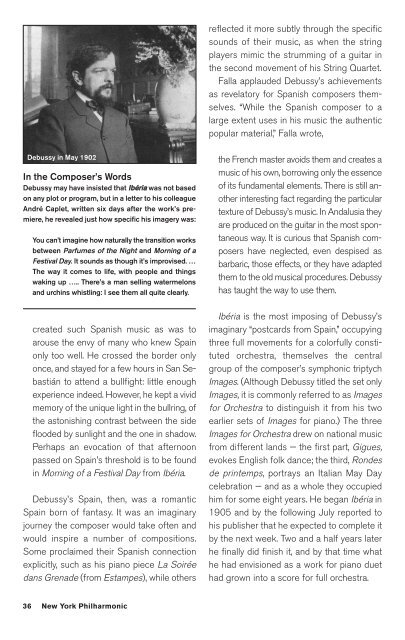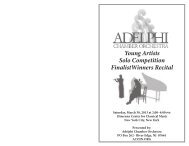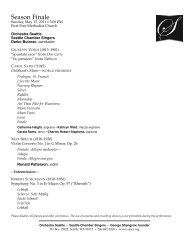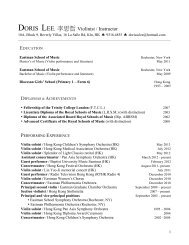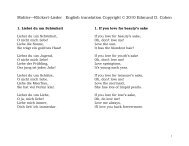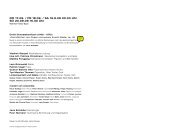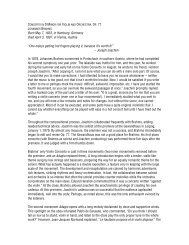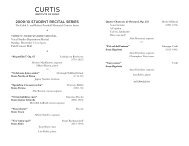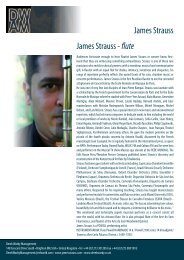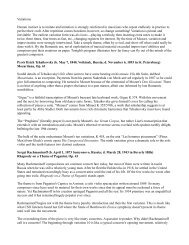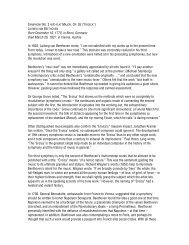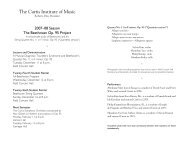download - InstantEncore
download - InstantEncore
download - InstantEncore
Create successful ePaper yourself
Turn your PDF publications into a flip-book with our unique Google optimized e-Paper software.
10-13 Mahler:Layout 1 10/3/11 11:38 AM Page 36<br />
Debussy in May 1902<br />
In the Composer’s Words<br />
Debussy may have insisted that IIbbéérriiaa was not based<br />
on any plot or program, but in a letter to his colleague<br />
André Caplet, written six days after the work’s premiere,<br />
he revealed just how specific his imagery was:<br />
You can’t imagine how naturally the transition works<br />
between Parfumes of the Night and Morning of a<br />
Festival Day. It sounds as though it’s improvised. …<br />
The way it comes to life, with people and things<br />
waking up ….. There’s a man selling watermelons<br />
and urchins whistling: I see them all quite clearly.<br />
created such Spanish music as was to<br />
arouse the envy of many who knew Spain<br />
only too well. He crossed the border only<br />
once, and stayed for a few hours in San Sebastián<br />
to attend a bullfight: little enough<br />
experience indeed. However, he kept a vivid<br />
memory of the unique light in the bullring, of<br />
the astonishing contrast between the side<br />
flooded by sunlight and the one in shadow.<br />
Perhaps an evocation of that afternoon<br />
passed on Spain’s threshold is to be found<br />
in Morning of a Festival Day from Ibéria.<br />
Debussy’s Spain, then, was a romantic<br />
Spain born of fantasy. It was an imaginary<br />
journey the composer would take often and<br />
would inspire a number of compositions.<br />
Some proclaimed their Spanish connection<br />
explicitly, such as his piano piece La Soirée<br />
dans Grenade (from Estampes), while others<br />
36 New York Philharmonic<br />
reflected it more subtly through the specific<br />
sounds of their music, as when the string<br />
players mimic the strumming of a guitar in<br />
the second movement of his String Quartet.<br />
Falla applauded Debussy’s achievements<br />
as revelatory for Spanish composers themselves.<br />
“While the Spanish composer to a<br />
large extent uses in his music the authentic<br />
popular material,” Falla wrote,<br />
the French master avoids them and creates a<br />
music of his own, borrowing only the essence<br />
of its fundamental elements. There is still another<br />
interesting fact regarding the particular<br />
texture of Debussy’s music. In Andalusia they<br />
are produced on the guitar in the most spontaneous<br />
way. It is curious that Spanish composers<br />
have neglected, even despised as<br />
barbaric, those effects, or they have adapted<br />
them to the old musical procedures. Debussy<br />
has taught the way to use them.<br />
Ibéria is the most imposing of Debussy’s<br />
imaginary “postcards from Spain,” occupying<br />
three full movements for a colorfully constituted<br />
orchestra, themselves the central<br />
group of the composer’s symphonic triptych<br />
Images. (Although Debussy titled the set only<br />
Images, it is commonly referred to as Images<br />
for Orchestra to distinguish it from his two<br />
earlier sets of Images for piano.) The three<br />
Images for Orchestra drew on national music<br />
from different lands — the first part, Gigues,<br />
evokes English folk dance; the third, Rondes<br />
de printemps, portrays an Italian May Day<br />
celebration — and as a whole they occupied<br />
him for some eight years. He began Ibéria in<br />
1905 and by the following July reported to<br />
his publisher that he expected to complete it<br />
by the next week. Two and a half years later<br />
he finally did finish it, and by that time what<br />
he had envisioned as a work for piano duet<br />
had grown into a score for full orchestra.


